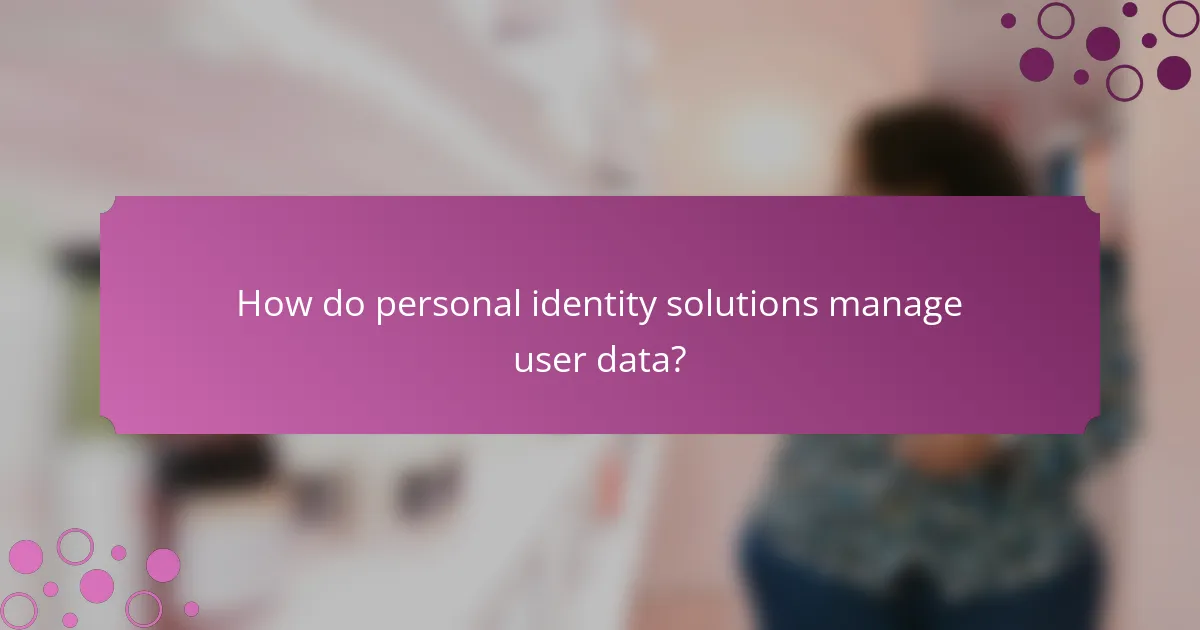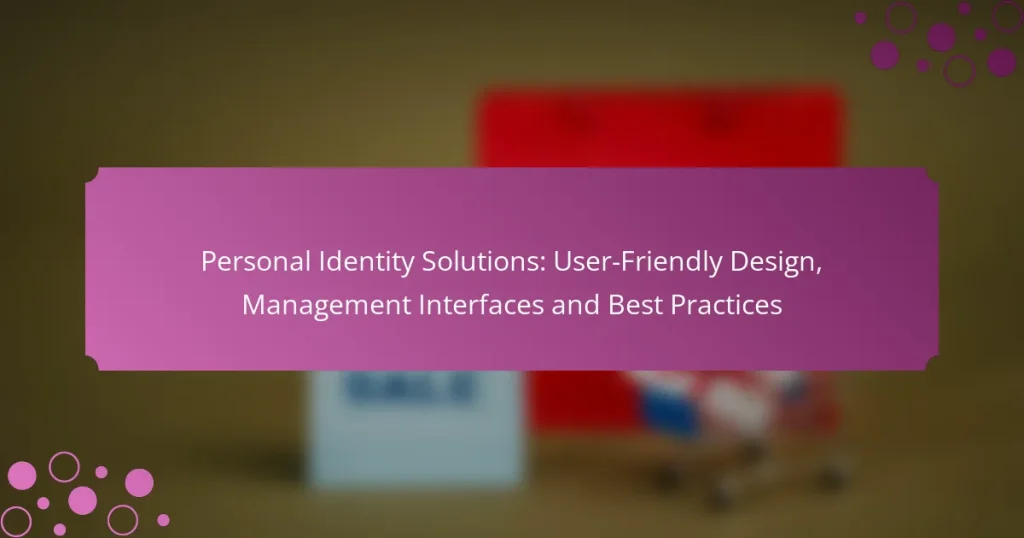Personal identity solutions are essential for enhancing security and user experience in today’s digital landscape. By focusing on user-friendly design, effective management interfaces, and adherence to best practices, organizations can streamline identity verification and authentication processes while ensuring data privacy and compliance with regulations.

What are the best personal identity solutions in the UK?
The best personal identity solutions in the UK include a range of technologies designed to enhance security and user experience. These solutions focus on identity verification, biometric authentication, decentralized identity management, and streamlined access through single sign-on systems.
Identity verification software
Identity verification software is essential for confirming the authenticity of user identities. These systems typically use documents like passports or driver’s licenses and may incorporate facial recognition technology to ensure that the person presenting the ID is its legitimate owner.
When selecting identity verification software, consider factors such as compliance with UK regulations, integration capabilities with existing systems, and user experience. Popular options include services that offer real-time verification and support for multiple document types.
Biometric authentication systems
Biometric authentication systems use unique physical characteristics, such as fingerprints or facial features, to verify identity. These systems provide a high level of security, as they are difficult to replicate or forge.
In the UK, biometric solutions are increasingly used in banking and secure access applications. When implementing these systems, ensure they comply with data protection regulations and consider user acceptance, as some individuals may have privacy concerns.
Decentralized identity platforms
Decentralized identity platforms empower users to control their personal information without relying on a central authority. These platforms use blockchain technology to secure and verify identities, allowing users to share only the necessary information with service providers.
In the UK, decentralized identity solutions are gaining traction due to their potential for enhanced privacy and security. When evaluating these platforms, consider their interoperability with existing systems and the ease of use for end-users.
Identity management services
Identity management services streamline the process of managing user identities across various applications and systems. These services often include features like user provisioning, access control, and audit trails to ensure compliance and security.
In the UK, organizations should look for identity management solutions that offer robust security features and scalability to accommodate growth. It’s crucial to assess the vendor’s reputation and support services before making a decision.
Single sign-on solutions
Single sign-on (SSO) solutions allow users to access multiple applications with one set of credentials, enhancing convenience and security. SSO reduces password fatigue and the risk of password-related breaches.
When implementing SSO in the UK, ensure that the solution integrates well with existing systems and provides strong authentication methods. Consider user training to maximize adoption and minimize potential security risks associated with credential sharing.

How to choose a personal identity management interface?
Choosing a personal identity management interface involves evaluating usability, integration, and scalability. A well-designed interface should simplify user interactions while effectively managing identity data across various platforms.
User experience design principles
User experience (UX) design principles are crucial for creating an effective personal identity management interface. Focus on simplicity, ensuring that users can navigate the system intuitively without extensive training. Use clear labeling and logical workflows to enhance usability.
Consider incorporating responsive design to accommodate various devices, as many users access identity management tools on mobile devices. Regular user testing can help identify pain points and areas for improvement, ensuring the interface remains user-friendly.
Integration capabilities with existing systems
Integration capabilities are essential for a personal identity management interface to function seamlessly within an organization’s existing ecosystem. Look for solutions that support standard protocols like SAML, OAuth, and OpenID Connect to facilitate smooth data exchange between systems.
Evaluate the interface’s ability to connect with commonly used applications, such as CRM systems or HR software. A flexible API can enhance integration, allowing for custom connections tailored to specific organizational needs.
Scalability and performance metrics
Scalability is a key factor when selecting a personal identity management interface, as it should accommodate growth in user numbers and data volume without compromising performance. Assess the system’s ability to handle increased loads, ideally with minimal latency during peak usage times.
Performance metrics such as response time and uptime are vital indicators of reliability. Aim for systems that maintain response times in the low tens of milliseconds and offer uptime guarantees of 99.9% or higher to ensure consistent access for users.

What are the best practices for personal identity solutions?
The best practices for personal identity solutions focus on ensuring data privacy, managing user consent, and conducting regular security audits. Implementing these strategies helps organizations protect user information and maintain trust while complying with regulations.
Data privacy compliance strategies
Data privacy compliance strategies involve adhering to regulations such as GDPR or CCPA, which set standards for data protection. Organizations should conduct thorough assessments to identify applicable laws and implement necessary changes to their data handling practices.
Key steps include establishing clear data collection policies, ensuring data minimization, and providing transparency about data usage. Regular training for employees on compliance requirements is also essential to maintain a culture of data protection.
User consent management
User consent management is crucial for ensuring that individuals have control over their personal information. Organizations should implement clear consent mechanisms, allowing users to easily grant or withdraw consent for data processing activities.
Best practices include using straightforward language in consent forms, providing options for granular consent, and maintaining records of user consent. Regularly reviewing and updating consent practices helps align with evolving regulations and user expectations.
Regular security audits
Regular security audits are vital for identifying vulnerabilities in personal identity solutions. These audits should assess both technical and procedural aspects of security, ensuring that systems are robust against potential threats.
Organizations should schedule audits at least annually and after significant changes to their systems. Engaging third-party security experts can provide an objective evaluation and help uncover hidden risks that internal teams may overlook.

What are the key features of user-friendly design in identity solutions?
User-friendly design in identity solutions focuses on enhancing user experience through intuitive interfaces, responsive layouts, and accessibility. These features ensure that users can easily manage their identities while minimizing frustration and confusion.
Intuitive navigation
Intuitive navigation is essential for helping users find what they need quickly and efficiently. Clear labeling, logical grouping of information, and a consistent layout contribute to a seamless experience. For instance, using familiar icons and straightforward menus can significantly reduce the learning curve for new users.
To enhance intuitive navigation, consider implementing breadcrumb trails, which allow users to track their location within the interface. Additionally, providing a search function can help users locate specific features or information without unnecessary clicks.
Responsive design
Responsive design ensures that identity solutions function well across various devices and screen sizes. This adaptability is crucial as users increasingly access services through smartphones and tablets. A responsive layout adjusts elements dynamically, maintaining usability regardless of the device.
When designing responsive interfaces, prioritize touch-friendly elements and ensure that text remains legible on smaller screens. Testing across different devices and browsers can help identify and resolve potential issues, leading to a more consistent user experience.
Accessible interfaces
Accessible interfaces are designed to accommodate users with diverse abilities, ensuring that everyone can effectively manage their identity. This includes adhering to established accessibility standards, such as the Web Content Accessibility Guidelines (WCAG), which provide a framework for creating inclusive digital experiences.
To improve accessibility, use high-contrast color schemes, provide alt text for images, and ensure that all interactive elements are keyboard navigable. Regularly testing your interface with assistive technologies can help identify barriers and enhance usability for all users.

How do personal identity solutions manage user data?
Personal identity solutions manage user data through a combination of secure data handling practices, including encryption, storage, and compliance with regulations. These systems prioritize user privacy and data integrity while enabling efficient access and management of personal information.
Data encryption methods
Data encryption methods are essential for protecting user data from unauthorized access. Common techniques include symmetric encryption, where the same key is used for both encryption and decryption, and asymmetric encryption, which employs a pair of keys for added security.
For practical implementation, solutions often use standards like AES (Advanced Encryption Standard) for symmetric encryption and RSA (Rivest-Shamir-Adleman) for asymmetric encryption. It’s crucial to regularly update encryption protocols to counter evolving threats.
Data storage regulations
Data storage regulations dictate how personal information must be handled and protected. In the European Union, the General Data Protection Regulation (GDPR) sets strict guidelines for data storage, requiring explicit consent from users and ensuring their right to access and delete their data.
In the United States, regulations vary by state, with laws like the California Consumer Privacy Act (CCPA) providing similar protections. Organizations must stay informed about applicable regulations to avoid penalties and ensure compliance.

